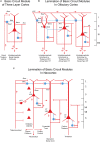An Evolutionary Microcircuit Approach to the Neural Basis of High Dimensional Sensory Processing in Olfaction
- PMID: 33994949
- PMCID: PMC8120314
- DOI: 10.3389/fncel.2021.658480
An Evolutionary Microcircuit Approach to the Neural Basis of High Dimensional Sensory Processing in Olfaction
Abstract
Odor stimuli consist of thousands of possible molecules, each molecule with many different properties, each property a dimension of the stimulus. Processing these high dimensional stimuli would appear to require many stages in the brain to reach odor perception, yet, in mammals, after the sensory receptors this is accomplished through only two regions, the olfactory bulb and olfactory cortex. We take a first step toward a fundamental understanding by identifying the sequence of local operations carried out by microcircuits in the pathway. Parallel research provided strong evidence that processed odor information is spatial representations of odor molecules that constitute odor images in the olfactory bulb and odor objects in olfactory cortex. Paleontology provides a unique advantage with evolutionary insights providing evidence that the basic architecture of the olfactory pathway almost from the start ∼330 million years ago (mya) has included an overwhelming input from olfactory sensory neurons combined with a large olfactory bulb and olfactory cortex to process that input, driven by olfactory receptor gene duplications. We identify a sequence of over 20 microcircuits that are involved, and expand on results of research on several microcircuits that give the best insights thus far into the nature of the high dimensional processing.
Keywords: content addressable memory; evolution; lateral inhibition; mammalian paleontology; microcircuit; neuronal microcircuits; olfactory processing; sensory dimensionality.
Copyright © 2021 Shepherd, Rowe and Greer.
Conflict of interest statement
The authors declare that the research was conducted in the absence of any commercial or financial relationships that could be construed as a potential conflict of interest.
Figures








Similar articles
-
Performance of a Computational Model of the Mammalian Olfactory System.In: Persaud KC, Marco S, Gutiérrez-Gálvez A, editors. Neuromorphic Olfaction. Boca Raton (FL): CRC Press/Taylor & Francis; 2013. Chapter 6. In: Persaud KC, Marco S, Gutiérrez-Gálvez A, editors. Neuromorphic Olfaction. Boca Raton (FL): CRC Press/Taylor & Francis; 2013. Chapter 6. PMID: 26042330 Free Books & Documents. Review.
-
Local neurons play key roles in the mammalian olfactory bulb.J Physiol Paris. 2003 Jul-Nov;97(4-6):517-28. doi: 10.1016/j.jphysparis.2004.01.009. J Physiol Paris. 2003. PMID: 15242661 Review.
-
Effect of Interglomerular Inhibitory Networks on Olfactory Bulb Odor Representations.J Neurosci. 2020 Jul 29;40(31):5954-5969. doi: 10.1523/JNEUROSCI.0233-20.2020. Epub 2020 Jun 19. J Neurosci. 2020. PMID: 32561671 Free PMC article.
-
Construction of odor representations by olfactory bulb microcircuits.Prog Brain Res. 2014;208:177-203. doi: 10.1016/B978-0-444-63350-7.00007-3. Prog Brain Res. 2014. PMID: 24767483 Review.
-
Non-topographical contrast enhancement in the olfactory bulb.BMC Neurosci. 2006 Jan 24;7:7. doi: 10.1186/1471-2202-7-7. BMC Neurosci. 2006. PMID: 16433921 Free PMC article.
Cited by
-
Olfactory Development and Dysfunction: Involvement of Microglia.Physiology (Bethesda). 2025 Mar 1;40(2):0. doi: 10.1152/physiol.00037.2024. Epub 2024 Nov 5. Physiology (Bethesda). 2025. PMID: 39499248 Free PMC article. Review.
-
Timing Matters: Lessons From Perinatal Neurogenesis in the Olfactory Bulb.J Comp Neurol. 2025 Apr;533(4):e70045. doi: 10.1002/cne.70045. J Comp Neurol. 2025. PMID: 40128105
-
Inflammatory Response and Defects on Myelin Integrity in the Olfactory System of K18hACE2 Mice Infected with SARS-CoV-2.eNeuro. 2024 Jun 17;11(6):ENEURO.0106-24.2024. doi: 10.1523/ENEURO.0106-24.2024. Print 2024 Jun. eNeuro. 2024. PMID: 38834299 Free PMC article.
-
Olfactory bulb interneurons - The developmental timeline and targeting defined by embryonic neurogenesis.Mol Cell Neurosci. 2025 Jun;133:104007. doi: 10.1016/j.mcn.2025.104007. Epub 2025 Mar 22. Mol Cell Neurosci. 2025. PMID: 40122272
-
Neural connectivity of a computational map for fly flight control.bioRxiv [Preprint]. 2025 May 30:2025.05.29.656834. doi: 10.1101/2025.05.29.656834. bioRxiv. 2025. PMID: 40501886 Free PMC article. Preprint.
References
-
- Allison A. C. (1953). The morphology of the olfactory system in vertebrates. Biol. Rev. 28 195–277. 10.1111/j.1469-185x.1953.tb01376.x - DOI
Grants and funding
LinkOut - more resources
Full Text Sources
Other Literature Sources

